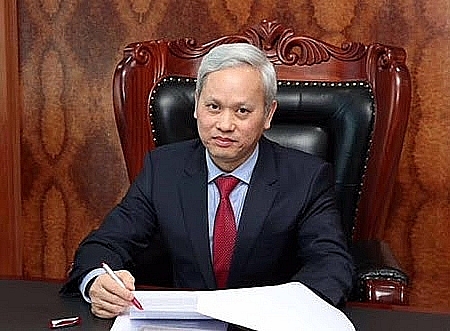 |
| Prof. Nguyen Bich Lam, former Director General of the General Statistics Office |
Could you please tell us the reasons that have influenced the increase of Vietnam’s gasoline prices in recent years? It is forecast that in the future, the price of gasoline will still fluctuate?
After basically controlling the Covid-19 pandemic, the world economy is facing strong increases in commodity prices, input material prices, especially gasoline prices due to the flourishing global economic activities, along with the rapidly increasing demand for gasoline, but oil production did not increase accordingly, leading to tight supply.
An important factor pushing up the price of oil is the fact that the alliance between the Organization of the Petroleum Exporting Countries Plus and its allies (OPEC +) announced that it will keep its plan to increase production, instead of limiting production as called for by the major oil-consuming countries such as the US and India. Besides, the world is suffering from an energy crisis and the winter of 2021 is forecasted to be harsh and cold, so countries are increasing their petroleum reserves, causing oil prices to increase.
In the future, the world petroleum market may still fluctuate, the petrol price is likely to increase. The world’s important energy forecasting organizations including OPEC, the International Energy Organization and the US Energy Information Administration all forecast that crude oil prices could reach $100/barrel in the summer of 2022.
As you have mentioned, the adjustment of petrol prices is mandatory in the face of the impacts of world petroleum prices, so how will this affect Vietnam’s economy?
Vietnam’s economy depends heavily on imported raw materials, with the proportion of the cost of imported materials in the total cost of raw materials of the whole economy reaching 37%. When the world gasoline price increases, it will increase the price of imported raw materials and domestic raw materials.
Therefore, along with the trend of world gasoline price fluctuations, in the first nine months of 2021, the domestic gasoline price was adjusted 16 times, making the average gasoline price in nine months increase by 24.1% over the same period last year. Previously, the consumer price index increased by 0.89%. In the production of goods and services, depending on the production process of each industry, it can be seen that most industries use petroleum. The cost of gasoline accounts for about 3.52% of the total production costs of the whole economy. This shows that petroleum accounts for a relatively high proportion and has a strong impact on the cost of manufacturing.
Notably, the increase in gasoline prices has a very strong impact on industries that use a lot of petroleum such as fishing, transporting goods and passengers by road, waterway and air.
Besides the direct impact of increasing product costs, the increase in gasoline prices also increases the prices of goods in circulation, putting more pressure on inflation, reducing the competitiveness of domestically produced goods, and negatively impacting economic growth. For the economy of our country, when gasoline prices increase by 10%, GDP will decrease by about 0.5% – a rather large decrease, reflecting the strong impact of gasoline price fluctuations on economic growth.
Notably, the increase in gasoline prices not only increases the cost of goods and services but also directly increases the consumer price index (CPI), affecting people’s income and spending. An increase of 10% in petrol price makes CPI increase by 0.36%. Besides that, spending on petroleum accounts for 1.5% of total household consumption. When gasoline prices rise, households will restructure and partially cut spending, which reduces aggregate demand in the economy.
To ensure the growth rate in 2021 as well as the target in 2022 and control inflation in the future, what solutions do we need to implement, sir?
The 4th wave of the Covid-19 pandemic is the reason why Vietnam’s economic growth in 2021 is forecast to reach a much lower level than the plan. The year 2022 is also an important year, creating the foundation for the implementation of the goals of the Five-Year Plan 2021-2025. At the opening session of the 2nd session of the 15th National Assembly, the Government proposed a socio-economic development plan in 2022, in which the growth rate of the gross domestic product would reach about 6-6.5%; the average CPI growth rate would be about 4%.
In order to successfully implement the socio-economic development goals in 2022 in the context of forecasting the international and domestic situation, advantages and challenges are intertwined. For example, the world economic growth is not stable and is forecast to be lower than 2021, the risks continue to increase; the resilience and resources of the State, businesses and people have decreased, and inflation pressure has been high.
Therefore, when developing a scenario of GDP growth and inflation target of 4% quarterly and for the whole of 2022 as a basis for providing appropriate and flexible management solutions. Besides the factors such as public investment capital, fiscal and monetary policies, petrol price fluctuations need to pay attention to minimize negative impacts on growth and inflation. Because for Vietnam’s economy, petroleum is one of the strategic goods, the selling price is managed on the basis of ensuring the interests between the state, businesses and people.
Thus, given the importance of petroleum for production and consumption in the economy, it is forecast that gasoline prices may continue to increase in the remaining months of 2021 and the first half of 2022. Accordingly, The Ministry of Industry and Trade, the Ministry of Finance and businesses need to keep abreast of developments in the petroleum market, the world political situation affecting petroleum supply in order to have solutions to tackle high oil prices to minimize the negative impact on growth and inflation in the remaining months of 2021 and 2022.
